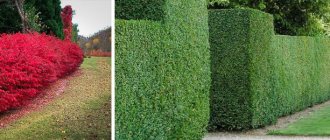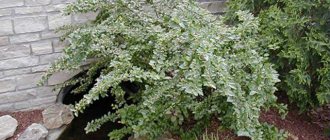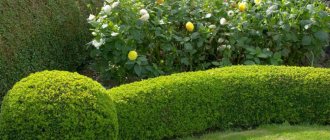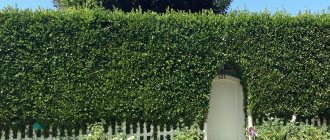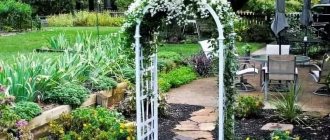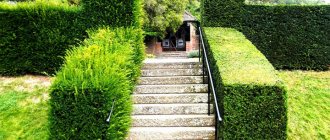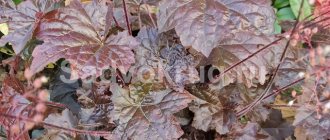A hedge is a fence made of bushes and trees that performs both decorative and protective functions. Reduces noise levels, protects from wind and dust. Hedging shrubs fit perfectly into any landscape style.
photo: Shrub fence
There are 2 types of hedges:
- Unformed - the plants are given complete freedom; only interfering and dry branches need to be trimmed.
- Shaped - the bushes are given a certain shape.
Fast-growing shrubs for fencing allow you to get a full-fledged green fence in a couple of seasons. Trees take much longer. Which shrubs to choose for a hedge? Let's ask the gardeners.
Fast growing shrubs for hedges
Dogwood
photo: Dogwood hedge
Shrubs for hedges, 2-5 meters high. It blooms profusely in March-April, then the leaves bloom and decorative fruits appear. The shrub is shade-tolerant; for planting a hedge, it is better to choose plants up to 2 years old. Prefers soil with neutral pH and well-lit areas. The annual plant grows slowly, but by the next season the growth rate increases to 30 cm per year.
Bladderwort
photo: Hedge of vesicle carp
The leaves of vesicle carp are similar to viburnum. It blooms in the first half of summer, winter-hardy and unpretentious. It does not like stagnant water - the root system quickly rots. Suitable for forming a free or formed hedge. It can reach 4 meters in height. Dwarf shrubs for hedges - up to 1 meter. On average, the vesicular carp grows by 40 cm per year. It retains its attractive appearance throughout the season.
Snowberry
photo: Snowberry hedge
This fast-growing hedge shrub belongs to the honeysuckle genus. Undemanding to soil quality and watering. The growth per year is 30-35 cm. The height of the finished hedge is 80-130 cm. The combination of bluish-green leaves with pink or white flowers looks very elegant. By the end of summer, unusual berries appear that resemble lumps of snow. They can persist on the hedge even in winter.
Boxwood
The evergreen shrub can easily grow even in the middle zone. But where frosts can be stronger than -20°C, it requires covering with burlap for the winter. But this moment is even difficult to attribute to his shortcomings. Rather, this can simply be called its feature.
Species with variegated leaves are less frost-resistant and grow only in the southern regions of Russia. Their height usually does not exceed 1.5 m, but in subtropical climates 5-meter evergreen walls can be found.
Just think! Evergreen boxwood lives up to 500-800 years!
- Drought resistant.
- Not demanding on watering.
- Remains decorative all year round.
- Easily adapts to drought.
It can grow in the shade and is absolutely not picky about soil.
Evergreen shrubs for hedges
Thuja
photo: Thuja Brabant hedge
There are more than 100 varieties of thuja, but two are used for hedges: Brabant and Smaragd. Brabant has a pronounced cone-shaped crown, the height of the bush is up to 4 meters. Thuja grows 25-30 centimeters per year. Smaragd is less branched, growing by 20 cm per year. They love well-lit spaces; young plants need to be covered for the winter. To get a dense hedge, thujas are planted at a distance of 50-70 cm.
photo: Thuja Smaragd hedge
Boxwood
photo: Boxwood hedge
It grows quite slowly - up to 15-20 cm per year, but attracts gardeners with its decorative qualities and unpretentiousness. Boxwood produces a dense green hedge of regular geometric shape. Height – up to 1 meter. It takes root easily and loves warmth. If the cottage is located in a cold region, the boxwood will grow small. In severe frosts, shrubs need to be covered.
photo: Boxwood easily takes and “holds” geometric shapes
Important! Hedging shrubs such as boxwood are poisonous, so it is not advisable to choose it if there are small children in the family.
Juniper
photo: Juniper hedge
A shade-loving plant that tolerates winter well. Juniper does not need to be watered often; it is unpretentious to the quality of the soil. For hedges, it is better to choose cone-shaped varieties. Spreading ones are used to decorate borders. It grows by 20 cm per year, the height of the bush is up to 1.5 meters. Berries appear on plants older than 2 years. Planted in a checkerboard pattern, the distance between plants is at least 60 cm.
Landing
The process of planting plants for hedges can be divided into several basic stages:
- Marking the area for future plantings;
- Soil preparation;
- Directly planting plants in the ground.
Marking the area for future plantings . First, you need to decide on the height of the required fence, whether there will be cascades, etc. On a piece of paper you need to draw a plan: where and what you would like to see on your own site. If you are not confident in your own abilities, it is better to seek help from a qualified designer.
Then you need to mark the lines of the future fence directly on the ground. This is done using twine and pegs. You should not rely on “eyeballing”; mistakes will be extremely difficult to correct later.
Soil preparation . You need to take care of the soil in which the plants will be planted. It is necessary to take into account that this fence will grow for many years, so it will require high-quality fertilizer, and for certain types of shrubs and trees, drainage from river pebbles, expanded clay or broken bricks.
Clay soil is diluted with sand, and soil represented by sandy loam is diluted with loam. If there is a need to reduce acidity, lime is used, and peat is used to reduce alkalinity.
Then, along the pre-made marking, a trench or the required number of holes for each plant is dug. The trench width for a single-row fence is usually up to 50 centimeters, for a double-row fence - up to 90 centimeters, depth - up to 60 centimeters. Depending on the plant species used, they are planted with a distance between seedlings of up to 60 centimeters.
But the planting depth and distance between plants greatly depends on the purpose of the fence and the species composition of the plants. You shouldn’t forget about this, so you need to take this factor into account right away.
Directly planting plants in the ground . Most often, planting is carried out in spring or autumn. Although it is most correct to first prepare the soil (dig up, apply fertilizer) in the fall, and plant seedlings with the onset of spring. This way, they will have time to take root before the onset of persistent frosts and will be able to overwinter well. In the spring, the trench prepared for planting is dug again, the seedlings are buried to the level of the root collar and covered with soil. Then the soil around the plants is compacted and watered abundantly.
Shrubs for hedges that do not require regular cutting and pruning
Kalmiya
photo: Kalmia as a hedge shrub
Lush evergreen plant with beautiful flowering. It grows quite quickly - 25-30 cm per year. It is better to plant bushes in partial shade, in loose soil. Does not tolerate stagnation of water - the roots quickly rot. Each variety blooms differently. Gardeners prefer broad-leaved, multi-leaved and narrow-leaved Kalmia. The height of the bush is 1-1.5 meters. Flowering occurs at the end of spring.
Spiraea Wangutta
photo: Spiraea Vangutta as a hedge shrub
Large shrubs for hedges that take up a lot of space. Flexible shoots in spring are covered with spherical white inflorescences. The leaves are serrated, with a bluish tint. Grows quickly - up to 35 cm per year. The bush can grow up to 2 meters in height, the crown diameter is also 1-2 meters. An unpretentious plant that thrives in both shade and sun.
Caragana shrub
photo: Caragana bush hedge
Bush with openwork leaves and golden flowers. It grows actively, has a powerful root system, so it is often used on uneven areas. Caragana can grow up to 2 meters; it is better to plant in well-lit areas or in partial shade. It is unpretentious to soil quality and can withstand frost and drought. The most popular varieties are Globoza, Latifolia, Grandiflor.
Fruits and berries
A hedge can perform not only practical or decorative functions if it is created from fruit bushes. Recommended options:
- rose hip;
- blackberry;
- blackthorn;
- irga;
- gooseberry;
- honeysuckle;
- hawthorn;
- black and red chokeberry;
- sea buckthorn.
Recently, green fencing made of honeysuckle has been increasingly being formed in areas. This is a shrub with blue berries, distinguished by such qualities as frost resistance, productivity, decorativeness, early ripening and good immunity to diseases. However, it should be borne in mind that the fruits of some varieties are poisonous and unsuitable for food.
What hedge shrubs can be found in the forest?
Derain
photo: Fence made from deren bushes
The name of the hedge shrub is translated from Latin as “horn”. This plant has very strong bark. In nature it grows as a small tree or spreading bush. It reaches a height of 3 meters and a width of more than 5 meters. It can bloom twice per season: in late spring and early autumn. Such shrubs for hedges are unpretentious and take root well both in the shade and in illuminated areas. They love humidity. The most popular subspecies are white, offspring and red.
Rose hip
photo: Rosehip hedge
A fast-growing hedge shrub that acclimates well to any environment. Does not require regular pruning; more than 50 species grow in Russia. Fruits appear on plants older than 2 years. Flowering occurs in May-June. Over the course of a year it grows by 30-40 cm. Reaches 2 meters in height. Loves moist soils and well-lit areas.
Blackberry
photo: Blackberries can be used to create a hedge
In nature it grows as a shrub or vine. Powerful root system, flexible stem. Even if part of the bush freezes in winter, it quickly recovers. If you place a support nearby, you can get a fence more than 2 meters high. It blooms in June, the berries ripen towards the end of August. It does not require special care, annual growth is from 30 cm. The shrub is quite prickly.
Deciduous shrubs
An interesting option is deciduous shrubs, which are much easier to form. Most species shed their leaves for the winter, but some have evergreen foliage, providing natural fencing with an attractive appearance year-round. Evergreens can create a fast-growing hedge, so it's worth researching and choosing which varieties are best. Below is an overview of the best low-maintenance shrubs for green hedges.
Common privet
If you need to choose a variety that does not require careful care, be sure to choose privet for a beautiful hedge. This little-known name hides an extremely impressive plant.
The main benefits of privet:
- low requirements for growing conditions;
- care does not take much time.
To form a beautiful shape of privet, you need to regularly trim the bush twice a year, especially in the first years of life. This is a hedge-forming plant that is very resistant to the low temperatures typical of Russian winters.
Boxwood evergreen
Boxwood (buxus) is a popular shrub for deciduous hedges. Evergreen boxwood grows quickly. This is the most popular and affordable option for a fast-growing hedge. Boxwood is versatile and has many other uses:
- planted in separate bushes;
- forms small fences;
- creates dense, dense hedges.
Additional advantages of the axle:
- ease of cultivation;
- relatively low soil requirements;
- undemanding to the landing site.
Boxwood requires regular, intensive pruning. Even a novice amateur gardener can do the shaping; the bush is resistant to experiments and recovers quickly. To keep the axle under control, the pruning procedure is performed quite often. The plant does not require much effort and grows well in the gardens of busy people.
Boxwood is one of the best plants for a beautiful hedge, due to the ease of molding the crown. The bush is often used to create complex ornaments:
- framing a winding path;
- various forms;
- complex hedges with different heights.
Evergreen boxwood does not shed its leaves for the winter, maintaining its aesthetic appeal year-round.
Cotoneaster brilliant
A cotoneaster hedge is a popular solution. It is a deciduous shrub with straight, stiff shoots. Grows to a height of 1-2 meters. The leaves are dark green, have a beautiful shine, and in the fall they turn brown, orange, and yellow. Shape: elliptical or ovoid, 2-7 cm long and 1-3 cm wide, sharp at the apex.
Cotoneaster, which blooms in summer, produces pink, honey-colored flowers. Flowers are 5-6 mm in diameter, pink-green, with white ends of the petals, collected in inflorescences of 3-8 pieces. Flowering period: May-June.
Photo. Cotoneaster leaves and flowers
The fruits appear in October, first red or dark purple, then black spherical berries up to 1 cm in diameter. The berries ripen in August and fall quite quickly.
Photo. Cotoneaster fruits
Shiny cotoneaster is planted in sunny or semi-shaded places.
Benefits of cotoneaster:
- characterized by complete resistance to low temperatures;
- drought resistant;
- tolerant to soil: average need for fertility, prefers substrates that are light, permeable, with a slightly acidic or slightly alkaline pH, does not like wet, heavy soils;
- resistant to air pollution, recommended for planting in cities, near roads;
- tolerates pruning well - this is one of the best varieties of cotoneaster for forming hedges.
Features of a cotoneaster hedge: a honey-bearing plant, fruits suitable for birds, dense thickets can be formed.
Recommended for:
- home gardens;
- parks;
- street landscaping.
Plants are planted individually or in groups, often used for low hedges, and formed in low rows.
Photo. Cotoneaster brilliant in a curved hedge.
Evergreen barberry
Nurseries offer several varieties of evergreen barberry. A common option is Berberis Thunberg. Specimens differ in leaf color, shape, and plant height. Various types of barberry have a height of 50-300 centimeters.
Barberry Thunberg belongs to the most common species. The shrub is characterized by a wide, spreading bush, with shoots hanging to the ground. The indisputable advantage of barberry is the bright red berries that remain on the shoots in winter. Red fruits are a favorite delicacy of birds.
Barberry is recommended for:
- plantings in cities;
- strengthening slopes;
- creating hedges.
Varieties with colored leaves are readily used in home gardens. The bush blooms in May.
Favorable soil reaction: acidic. Location requirements: partial shade, sunny places.
Bladderwort viburnum
Dicotyledonous Physocarpus opulifolius is a shrub with dark purple leaves. In April, white, delicate flowers appear, collected in umbrellas, then turning into decorative, red berries. Without pruning, vesicular carp shoots reach a height of 2 meters, with an annual growth of 30 centimeters.
In sunny positions, the leaves of the bladderwort acquire a beautiful shade. The bush is unpretentious. It is easy to grow a beautiful living hedge from it.
The main attention should be paid to seedlings immediately after planting, watering is especially important. Thanks to regular watering, the shrub takes root well and grows quickly.
Bladderwort is resistant to:
- drought;
- frost;
- air pollution.
Due to its unpretentiousness to conditions and easy care, bladderwort is often planted on the streets, along pedestrian paths.
Euonymus
Fortune's euonymus is an evergreen shrub with round green shoots. Plant height is up to 3 meters. The leaves are ovate or elliptical, thick, 2-4 cm long, green with yellow edges. In winter, the foliage turns red: the colder it is, the more intense the color becomes. The flowers of the Emerald Gold variety are greenish-white, grouped in fairly large inflorescences.
The shrub loves fertile, humus, airy soils that are sufficiently moist. Euonymus should be planted in sunny or semi-shaded areas. Blooms in July. Frost-resistant, but can freeze in severe winters. Requires pruning 3 times a year:
- in spring;
- in June;
- in the first half of August to prepare the shoots for winter.
Sometimes the euonymus is planted under the crowns of trees, on which it rises to a height of up to 3 meters.
Lavrovishnya
This perennial shrub with a compact vertical crown is found in Southern Europe, North Africa, and Western Asia. Takes the form of a bush or small tree. The leaves are lanceolate, sharp, with wavy edges, hard. The flowers are small, collected in racemes. The fruit is a cherry-like berry, black in color, edible.
Attention! Cherry laurel seeds are poisonous!
The plant prefers warm, sunny positions. Requires fertile, well-drained, constantly moist soil. In winter you need to cut the shoots by half.
Hawthorn
Hawthorn is a shrub or low tree belonging to the Rosaceae family. It grows on many continents in its natural environment. Reaches a height of 3-6 meters, has vertical shoots. The leaves are oval with long petioles, carved - have 3-7 lobes. Cream-colored flowers are collected in umbrella-shaped panicles directed upwards. The fruits are up to 1 cm in diameter, scarlet-red in color, edible.
Hawthorn fruits are eaten raw and used for the production of canned food, tinctures, and wines.
Hawthorn is easy to grow if the conditions are right. A sunny or slightly shaded position is ideal. Suitable soil is sandy loam, fertile, moderately moist, although the shrub can grow even on poor soils.
Resistant to air pollution, therefore often used in urban landscaping. Hawthorn is frost-hardy, but young seedlings need to be covered. The plant is susceptible to pests and diseases (especially fungi). It is necessary to use prophylactic drugs.
Hawthorn looks beautiful on a formed hedge.
Holly (holly)
A tall shrub, growing up to 6 meters, belongs to the holly family (Aquifoliaceae). The leaves are characteristic, pointed, ovate, dark, shiny on the upper part of the plate. It blooms from May to June, producing small, white, dioecious flowers. In September, extremely decorative red berries appear, remaining on the bush all winter. To produce fruit, male and female specimens are planted together.
Attention! Holly berries are poisonous.
The plant is used in herbal medicine, in the treatment of runny nose, rheumatism.
Holly grows easily and is undemanding to agricultural technology. Grows well in partial shade, on acidic, permeable, sandy-clay soil. The soil needs to be slightly moist or moderately dry. The bush allows intensive pruning.
In the garden, holly should be planted in shady areas where many plants do not want to grow. On acidic marshy soils, in the shaded corners of the site, it will create dense decorative fences.
Flowering shrubs for hedges
Mahonia holly
photo: Mahonia holly hedge
Belongs to the barberry family. A spectacular fast-growing shrub for hedges, up to 2 meters high. The designers also nicknamed it the holly grape for its characteristic carved leaves. In spring and summer they are green, and in autumn they turn bronze-red. Flowering occurs at the end of spring. The inflorescences are large and yellow. In a year, mahonia can grow by 20-25 cm.
Forsythia
photo: Forsythia hedge
Such hedge bushes will decorate any area. In early spring, the plant is covered with golden inflorescences. Flowering continues from late April to June. The branches are long and graceful, growing up to 2 meters. Forsythia needs to be covered for the winter. The best place for landing is a well-lit area. In the shade the bush will bloom weakly. Pruning is done annually. Recommended varieties: oval-leaved, European, Giralda.
Barberry Thunberg
photo: Thunberg barberry hedge
The name of the hedge bush was given in honor of the Swedish naturalist Carl Thunberg. This subspecies of barberry reaches a height of 2.5 meters. Loves the sun and grows quickly. Foliage can be golden brown, purple, green, burgundy. It blooms with white inflorescences in May, and fruits form at the end of August. The barberry crown is dense, making the hedge dense. There are dwarf varieties for border landscaping.
Decorative
Pursuing exclusively decorative purposes of designing a site, choose shrubs that are distinguished by lush flowering, bright fruits or unusual leaf colors:
- mahonia holly;
- forsythia;
- Thunberg barberry;
- weigela;
- hydrangea;
- spirea;
- action;
- camellia japonica;
- lilac;
- Aubert's Highlander.
A green wall of flowering shrubs listed above will be an excellent decoration for any area, catching the eye and creating a great mood.
Characteristics and features of hedge shrubs
| Shrub name | Difficulty of care | Evergreen or not | Flowering | Perennial | Notes |
| Dogwood | Average | No | Yes | Yes | There are more than 50 species of dogwood. Grows quickly. |
| Bladderwort | Simple | No | Yes | Yes | About 20 varieties. Fast growing. |
| Snowberry | Simple | No | Yes | Yes | 15 types of shrubs. Refers to fast growing. |
| Thuja | Average | Yes | No | Yes | More than 100 varieties. It grows slowly. |
| Boxwood | Simple | Yes | No | Yes | More than 100 species. The shrub grows slowly. |
| Juniper | Simple | Yes | No | Yes | About 70 species are found in nature, of which 15 are cultivated. It grows slowly. |
| Kalmiya | Average | Yes | Yes | Yes | There are 10 species of shrubs belonging to this genus. Grows quickly. |
| Spirea | Simple | No | Yes | Yes | There are 90 species of spirea. It has spectacular flowering. |
| Caragana shrub | Simple | No | Yes | There are annual and perennial varieties | The genus Caragana includes 70 species. Growing actively. |
| Derain | Simple | No | Yes | Yes | More than 10 types. Grows at an average speed. |
| Rose hip | Average | No | Yes | There are annual and perennial varieties | More than 50 species grow in Russia, and there are more than 300 in the world. It grows quickly. |
| Blackberry | Simple | No | Yes | There are annual and perennial varieties | More than 200 species. Grows quickly, needs additional support. |
| Mahonia | Average | Yes | Yes | Yes | More than 50 types of mahonia. It grows slowly. |
| Forsythia | Complex | No | Yes | Yes | There are 6 known types of forsythia, the most popular is European. It grows slowly. |
| Barberry | Simple | There are deciduous and evergreen varieties | Yes | Yes | More than 100 types of barberry. Unpretentious, grows quickly. |
Trimming hedge bushes
Haircut and pruning are basic hedge care activities. They help preserve the beauty of the composition and the health of the plants. It is very important to perform pruning at a strictly established period for each shrub, otherwise you can simply destroy the plant.
First pruning of bushes in a hedge
Trimming after planting promotes the development of a strong root system and stimulates shoot growth:
- For deciduous plants. During the pruning process, dry and weak shoots are removed. A spreading bush is cut at a height of 35-40 cm, weak plants - at a height of 15 cm. Approximately 1/3 of the length of the seedlings is left. If the hedge was planted in the fall, pruning is done in the spring. A hedge formed in spring or summer can be tidied up after planting.
- For coniferous plants. These shrubs have well-formed crowns, so they are not pruned in the first year. If necessary, only damaged and dried shoots are removed in July-August.
| Shrubs | Trim time | How to trim | |
| Krona | Lateral sprouts | ||
| Deciduous | If planted in autumn, prune in spring; If planted in spring/summer - a week after planting | 30 – 35 cm above the ground | 15 cm |
| Conifers | July - early August, no earlier than a year after planting | The tops are cut off by 10-15 cm | 5-10 cm |
Useful tips for gardeners
- If the hedge has a complex shape, it is better for beginners to cut it according to a template - it is made from cardboard or chipboard.
- Coniferous hedges are pruned in July-August. In the fall, the shoots are not touched, otherwise they may not have time to come into force and will suffer from the cold.
- If you trim your hedge frequently, you will need to apply fertilizer. The optimal period is early spring. You can use both compost and multi-component fertilizers.
- You will need the following tools: pruning shears, loppers (for thick branches), electric shears (for forming a hedge). It is important that the tool fits comfortably in your hand and is not heavy.
Pruning when the hedge has grown
To make the hedge look neat and well-groomed, it needs to be trimmed. Deciduous bushes are pruned twice a year, coniferous bushes - once a year as necessary (if the plants do not grow well). If the hedge is unshaped, it is enough to trim it in the spring. Then the branches will grow thicker, but the shape of the bush will remain natural.
Molded deciduous hedges are trimmed once a month. Coniferous - twice a year, in spring and summer. Columnar-shaped shrubs are practically not pruned. Once every few years, thinning the crowns of deciduous plants is carried out - this procedure should be carried out in early spring before the buds appear. Old shoots are removed, and new shoots are cut by a third.
Important! You need to understand the difference between cutting and trimming. Trimming is simply maintaining the desired shape of the hedge, pruning is a procedure for caring for the plant. Pruning involves removing excess branches for more intensive growth and density.
How to choose plants for a hedge?
Not every crop is suitable for creating a beautiful living fence. To understand which plant to give preference to, it is necessary to assess whether it meets a number of the following requirements:
- unpretentiousness (especially for long hedges);
- frost resistance (except for the southern regions);
- growth rate;
- the presence of flowering or fruiting (depending on the preferences of the gardener);
- the ability to cut and give the crown a certain shape;
- duration of the decorative period;
- weak formation of lateral shoots and extra shoots;
- the ability of the selected types to be combined with each other;
- need for additional support / lack thereof;
- price of seedlings and materials for planting them.
Advice: if it is important to you that the hedge is not too expensive and does not take a lot of time and effort to maintain, then choose climbing plants.
Flowering bushes form a beautiful fragrant fence
